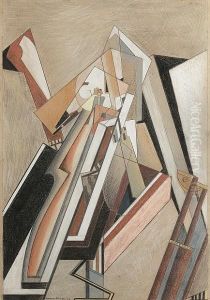Laurence Atkinson Paintings
Laurence Atkinson was a British artist, known primarily for his contributions as a sculptor, painter, and writer, but he was also involved in the development of the Vorticist movement in the early 20th century. Born on January 17, 1873, in Cleckheaton, Yorkshire, Atkinson showed an interest in art from an early age.
Initially trained as a designer, Atkinson worked in various industries, including textile design, before fully dedicating himself to fine art. His early work was influenced by the Arts and Crafts movement and Symbolism. However, his artistic direction took a significant turn after he moved to Munich in 1905, where he was exposed to the works of the German Expressionists and the burgeoning abstract art movements.
Atkinson was a pivotal figure in the London art scene upon his return to England. He became associated with key artists of the time, such as Wyndham Lewis and Ezra Pound, contributing to the avant-garde publication 'BLAST', which was the main voice of the Vorticists. The Vorticist movement, though short-lived, aimed to break away from the influence of past art forms and sought to reflect the dynamism of the modern world. Atkinson’s Vorticist phase saw him creating abstract works with bold geometric shapes and a sense of energetic movement.
During World War I, Atkinson's style evolved once more as he served on the Western Front. The horrors of war had a profound impact on him, leading to a series of powerful war-themed artworks that conveyed the brutality and tragedy of the conflict. His experiences during the war deepened his interest in spiritual and philosophical themes, which became increasingly prominent in his post-war work.
After the war, Atkinson continued to develop his art in various mediums, including sculpture, which became his primary focus in his later years. His sculptures often featured organic forms and were influenced by his interest in spiritualism and theosophy.
Laurence Atkinson's contributions to art were significant, particularly in his role as a bridge between various movements and his efforts to explore the spiritual in art. He passed away on September 21, 1931, in London. Although not as widely recognized today as some of his contemporaries, Atkinson's work continues to be respected for its innovation and expressive power.
